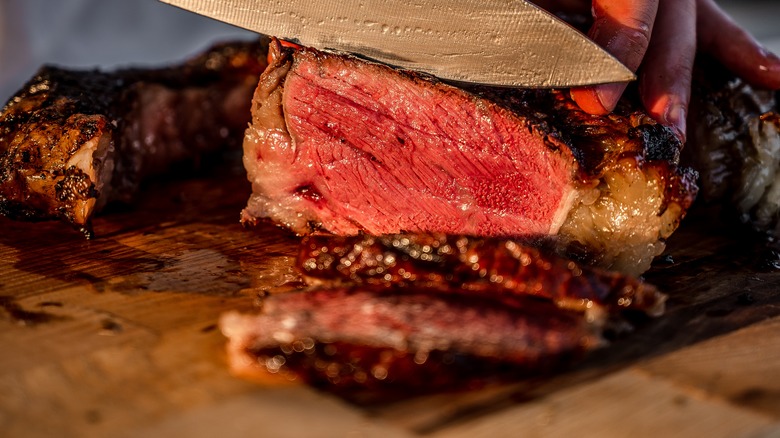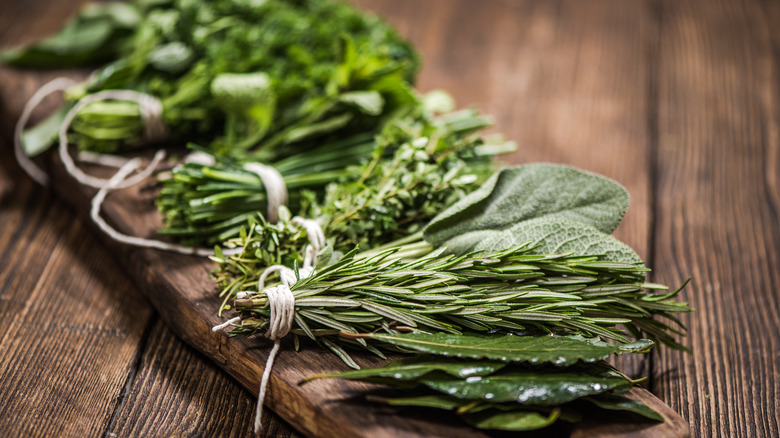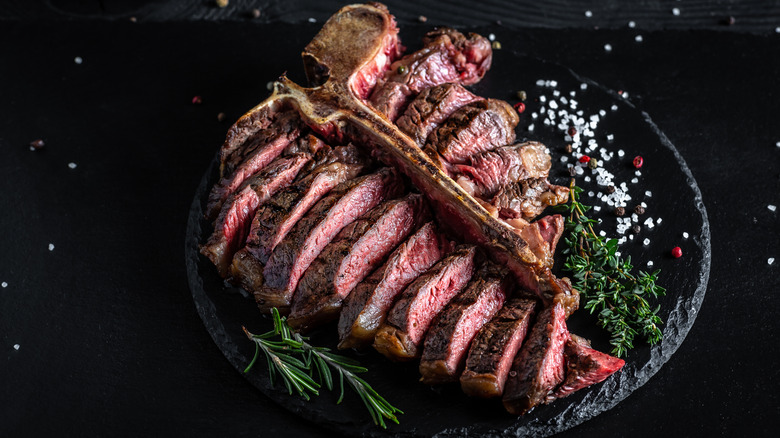Why You Should Season Your Cutting Board Instead Of Steak
If you or your guests enjoy a juicy steak, it's hard to go wrong with seasoned seared steak. But, to draw the full flavor of a quality cut, you need to carefully balance cooking time, seasoning, and rest.
When cooking steak, chefs are taught to listen for the sizzle. When uncooked steak hits the hot pan, water from within the steak rises rapidly to the surface and boils into steam creating a sizzling sound, per Exploratorium. In other words, the process of searing steak dries it out a little.
It doesn't stop there. When you cut into a piece of steak, you may have noticed liquid gushing out. As the meat cooks, the proteins in the muscles denature and are not able to hold as much liquid (per Meat Science). You may have also noticed the meat bulges. When you cut into it, it is a little like wringing out of an over-saturated sponge.
This is why so many chefs "rest" the steak after cooking it. Seven Sons Farms reports that resting the steak is at least as important as how you cook and season it. They explain resting the meat helps keep the moisture and flavor inside. As the meat's temperature cools, the juices have time to get reabsorbed into the muscle fibers and redistributed.
If you get impatient waiting for the meat to rest, try our new favorite seasoning technique that also lets the steak reabsorb its juices. This seasoning technique makes it easier to serve moist, well-seasoned steak within 20-30 minutes.
Create a steak seasoning board
While it may at first seem counterintuitive, seasoning the steak after cooking results in moist, perfectly seasoned meat. This technique also works for other tender, steaky meats.
You've heard of a butter board, right? This is a similar concept; but, instead, it is a steak seasoning board. To make one, combine the seasonings of your choice including liquids, oils, and even butter.
One benefit to this method is you can precisely control how much you want to cook the steak. Mixing in the seasonings within the pan can result in overcooking the steak. But adding the seasonings first may result in burning those seasonings, especially delicate herbs and rubs with sugars. Your Goldilocks solution is to blend the seasonings on a washable cutting board while your steak cooks.
How you season is as unique as your own taste palette. Today suggests a simple classic combination like freshly cracked pepper and chunks of salt. Have you ever had a waiter offer to add fresh ground pepper to your food? Raw ground pepper adds a ping to even the simplest of foods while the salt helps tenderize. Other flavor-enhancing options include finely minced garlic, freshly squeezed lemon or lime juice, or your favorite spice rub. Chopped herbs like thyme, rosemary, or sage also add a beguiling aroma and enhance the steak's umami flavor. Some steakhouses add fresh butter to finish the steak, butter is also a great option for your dressed steak seasoning board. Once you have your seasonings in place, the magic begins ...
Season your steak while it rests
When your steak is cooked to your liking, remove it from the pan and roll it in the seasonings before letting it rest. If you prefer bite-sized strips of steak, slice it and roll each slice in the seasoning mix. The steak's natural juices join the seasoning mix allowing the steak to reabsorb it along with your added seasonings. The steak rests while you work in the seasonings.
You may notice the meat cools down in the process just like it does with traditional resting methods. Seven Sons Farms suggests pre-heating your serving plates to avoid that cold meat experience. Chef's Vision offers a few methods to warm the plate including running them under hot water or preheating oven-safe plates in your oven's broiler. (Don't forget to use your oven mitts when you get your plates out of the oven.)
If you need a quick-yet-impressive dinner option, this may be it — whether you are treating friends, enjoying a family celebration, or even just having a date night. It may take less than 10 minutes to sear both sides of a thin steak, per Omaha Steaks, depending on how rare you like it. While searing, you multitask by dressing your seasoning board. Afterward, mix your steak and seasonings and let it rest while you pour the drinks or dish up the sides.
Once you taste the steak, don't be surprised if you can't resist giving yourself a chef's kiss. Just remember it all starts with a quality cut of steak.


